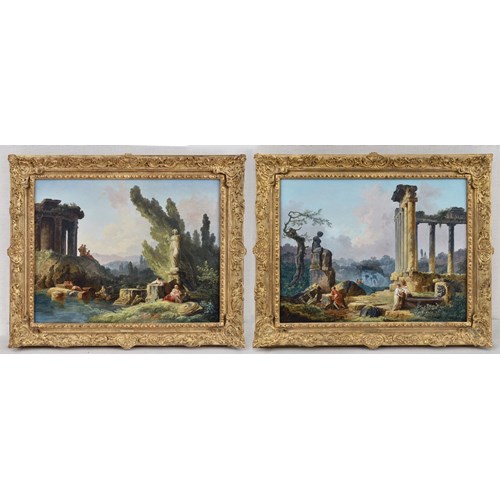Marketplace
Mary Magdalene
Pieter de Grebber
Mary Magdalene
Period 1600-1750, 17th century
Origin The Netherlands
Medium Oil on canvas
Dimension 98.5 x 79.5 cm (38³/₄ x 31¹/₄ inches)
Pieter de Grebber depicts the repentant sinner as a near life-sized half-length figure. She kneels with her hands folded in her lap, gazing at a crucifix leant against a rock. She is depicted before a neutral background, and only the rock - which partially obscures the figure - defines the pictorial space. The grey-green tone provides a backdrop before which the female figure with her fluidly painted flesh and vividly coloured clothing can shine more brightly.
Pieter de Grebber was a fascinating artistic personality generally related to the Dutch Classicists. He was a highly regarded painter who received commissions from the Stadtholder Frederick Hendrik and was among the artists charged with decorating the Oranjezaal of Huis ten Bosch in The Hague with monumental paintings. However, he was also a Catholic who carried out commissions for churches in Flanders and for the so-called 'Schuilkerken' in the Calvinist Northern provinces - clandestine churches that could not be recognised as such from the outside. Thus, biblical narratives and images of saints, such as Mary Magdalene, formed an important part of his repertoire. De Grebber was taught by his father and by Hendrick Goltzius, but like many artists of his generation, he was also strongly influenced by Rembrandt. His works also display the influence of the Utrecht Caravaggisti and Peter Paul Rubens, who he met during a sojourn to Antwerp. The virtuosic brushwork, vivid colour palette, half-length depiction of the saint and the neutral background all betray the influence of these various artistic styles.
This depiction of Mary Magdalene is closely related to a drawing kept in the Kupferstichkabinett in Berlin and a reversed engraving made by the artist himself (for the drawing cf. Elfried Bock and Jakob Rosenberg: Staatliche Museen zu Berlin, Kupferstichkabinett, Die niederländischen Meister, Beschreibendes Verzeichnis sämtlicher Zeichnungen, Berlin 1930, p. 146, no. 247). The present composition corresponds to the drawing (fig. 1) in all details, with the exception of the missing crucifix and the addition of trailing plants in the painting, which soften the contours of the rock. In the mirrored engraving (fig. 2), the saint wears a necklace and her veil is not transparent. Pieter de Grebber presumably made the drawing after the painting to use it as a basis for the engraving.
Pieter de Grebber was a fascinating artistic personality generally related to the Dutch Classicists. He was a highly regarded painter who received commissions from the Stadtholder Frederick Hendrik and was among the artists charged with decorating the Oranjezaal of Huis ten Bosch in The Hague with monumental paintings. However, he was also a Catholic who carried out commissions for churches in Flanders and for the so-called 'Schuilkerken' in the Calvinist Northern provinces - clandestine churches that could not be recognised as such from the outside. Thus, biblical narratives and images of saints, such as Mary Magdalene, formed an important part of his repertoire. De Grebber was taught by his father and by Hendrick Goltzius, but like many artists of his generation, he was also strongly influenced by Rembrandt. His works also display the influence of the Utrecht Caravaggisti and Peter Paul Rubens, who he met during a sojourn to Antwerp. The virtuosic brushwork, vivid colour palette, half-length depiction of the saint and the neutral background all betray the influence of these various artistic styles.
This depiction of Mary Magdalene is closely related to a drawing kept in the Kupferstichkabinett in Berlin and a reversed engraving made by the artist himself (for the drawing cf. Elfried Bock and Jakob Rosenberg: Staatliche Museen zu Berlin, Kupferstichkabinett, Die niederländischen Meister, Beschreibendes Verzeichnis sämtlicher Zeichnungen, Berlin 1930, p. 146, no. 247). The present composition corresponds to the drawing (fig. 1) in all details, with the exception of the missing crucifix and the addition of trailing plants in the painting, which soften the contours of the rock. In the mirrored engraving (fig. 2), the saint wears a necklace and her veil is not transparent. Pieter de Grebber presumably made the drawing after the painting to use it as a basis for the engraving.
Period: 1600-1750, 17th century
Origin: The Netherlands
Medium: Oil on canvas
Signature: Signed in monogram lower center: P DG(joined).
Dimension: 98.5 x 79.5 cm (38³/₄ x 31¹/₄ inches)
More artworks from the Gallery






_T637485684740421746.jpg?width=500&height=500&mode=pad&scale=both&qlt=90&format=jpg)


